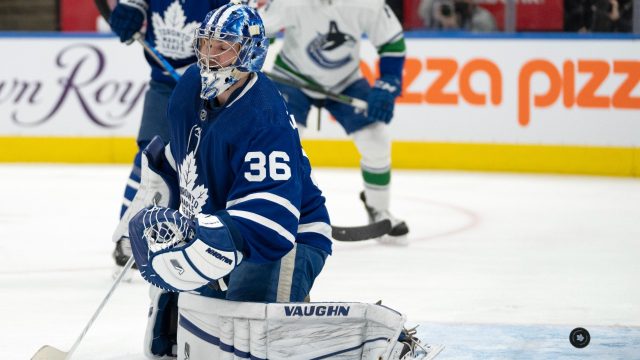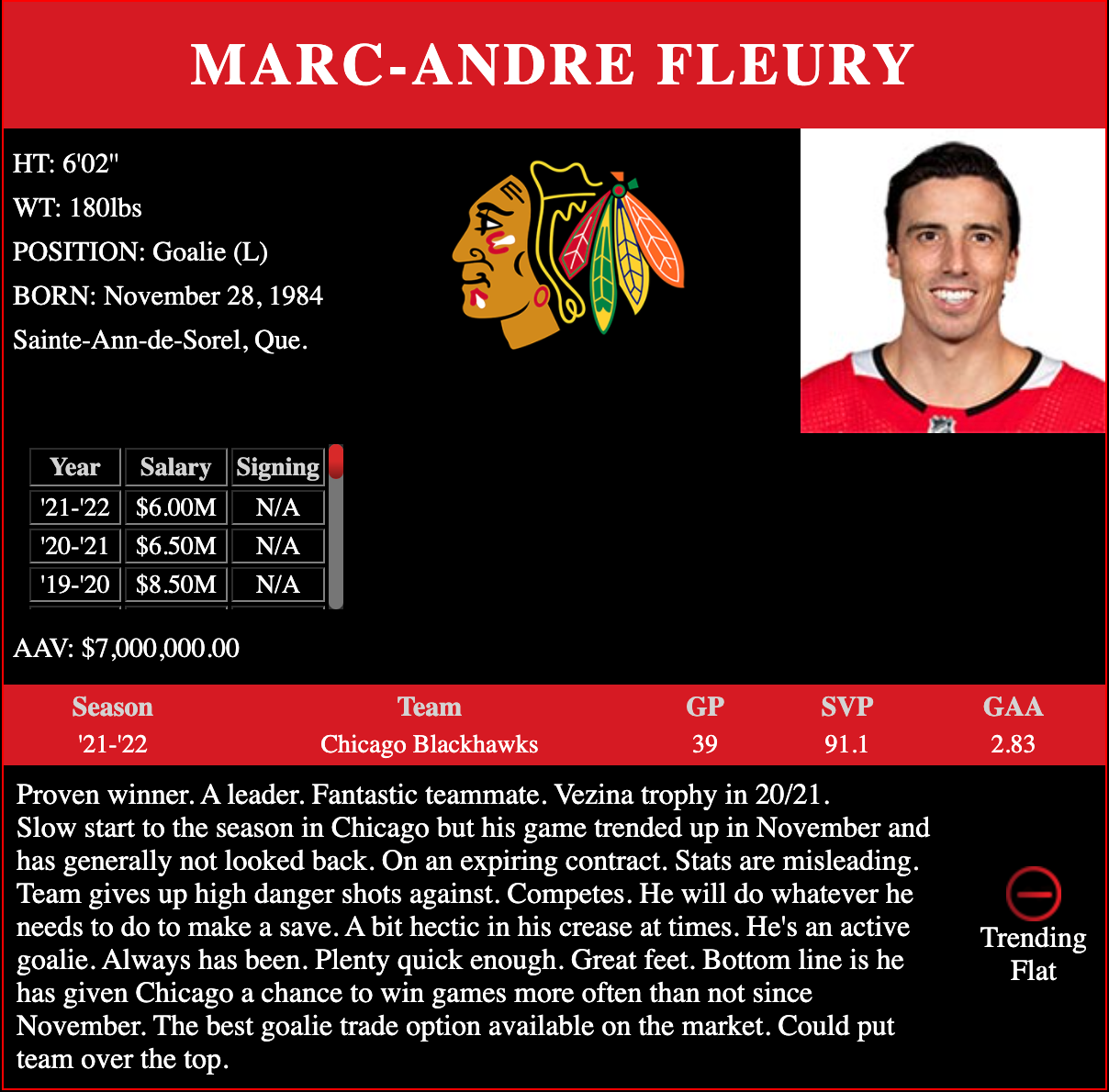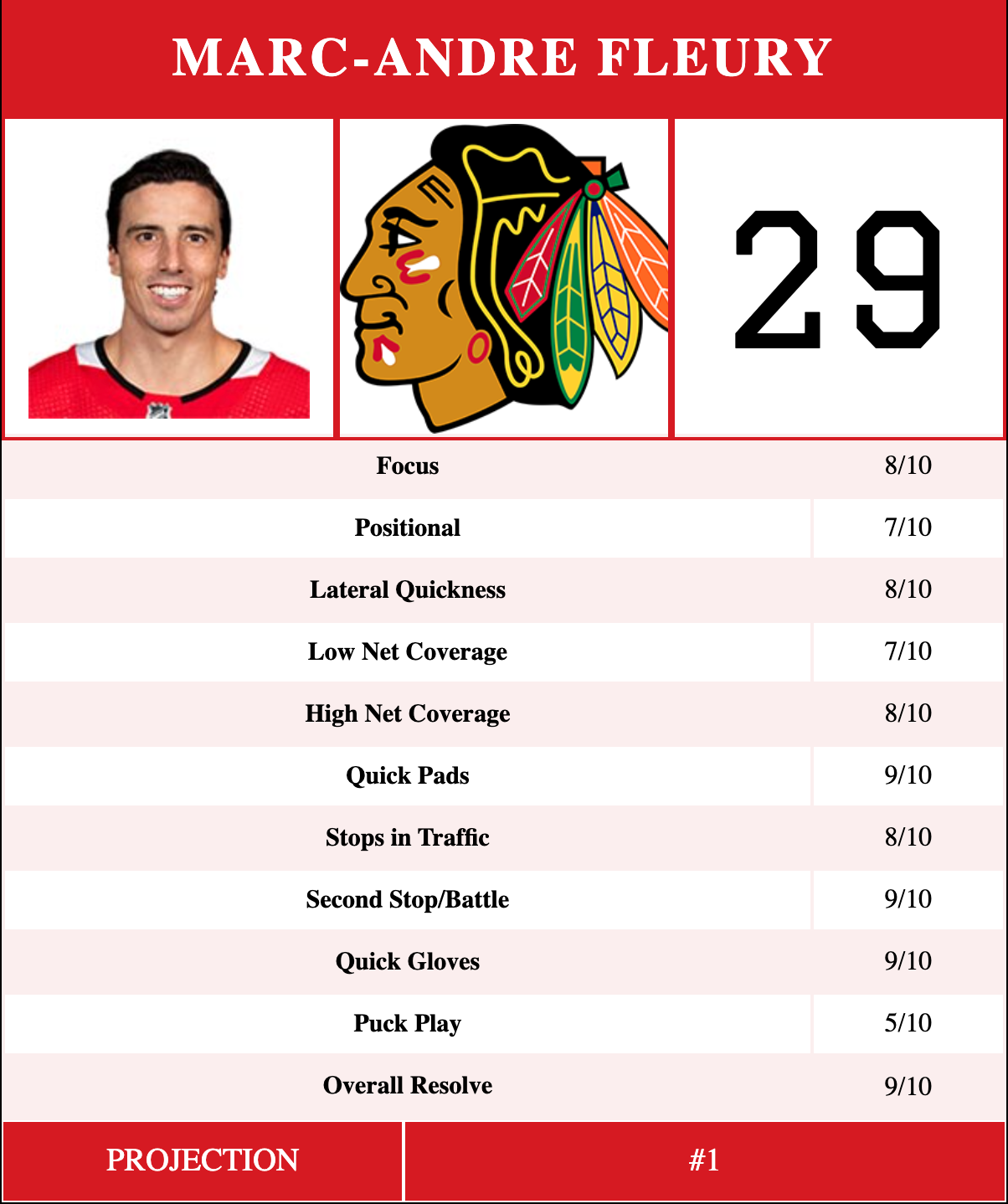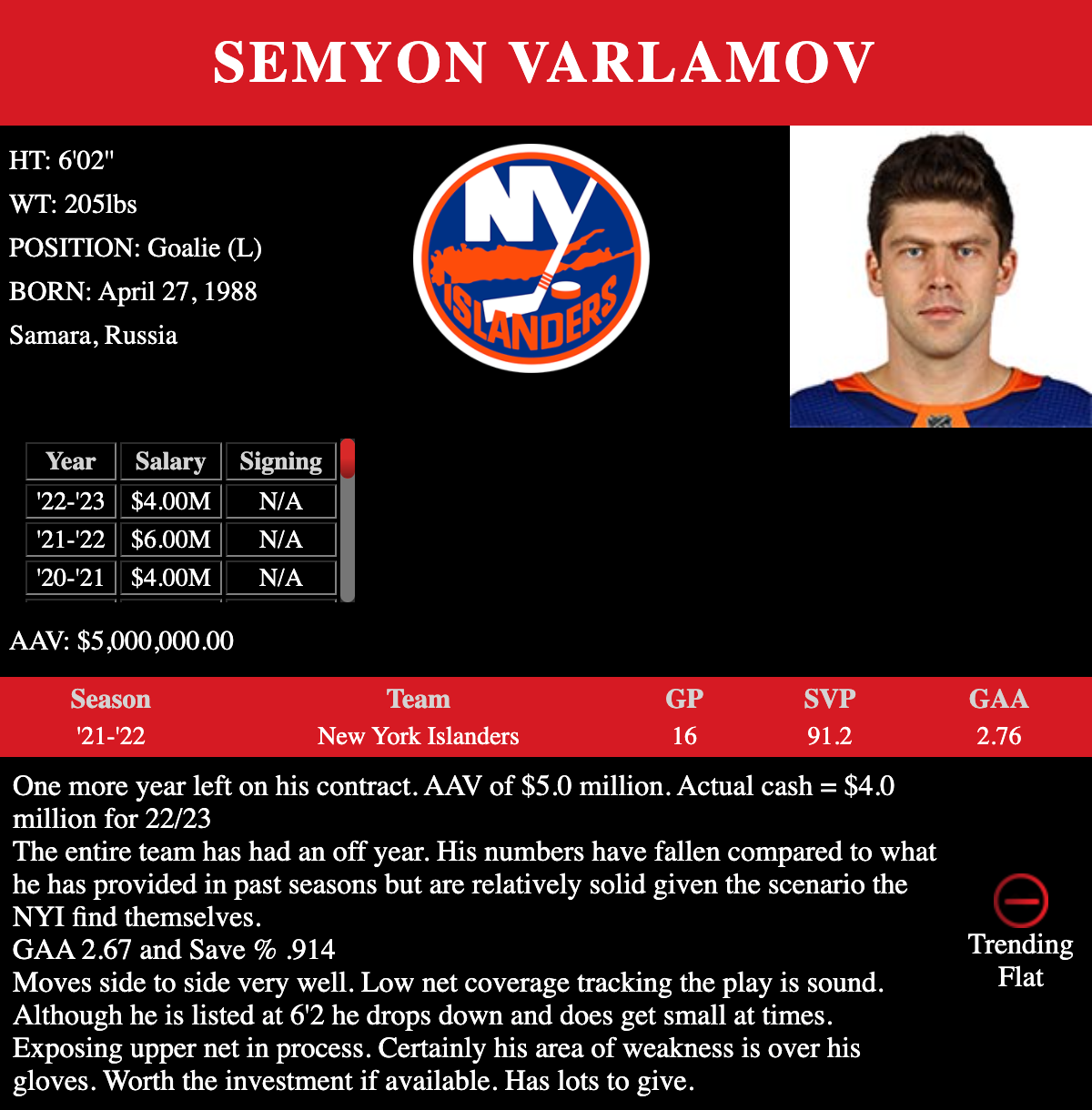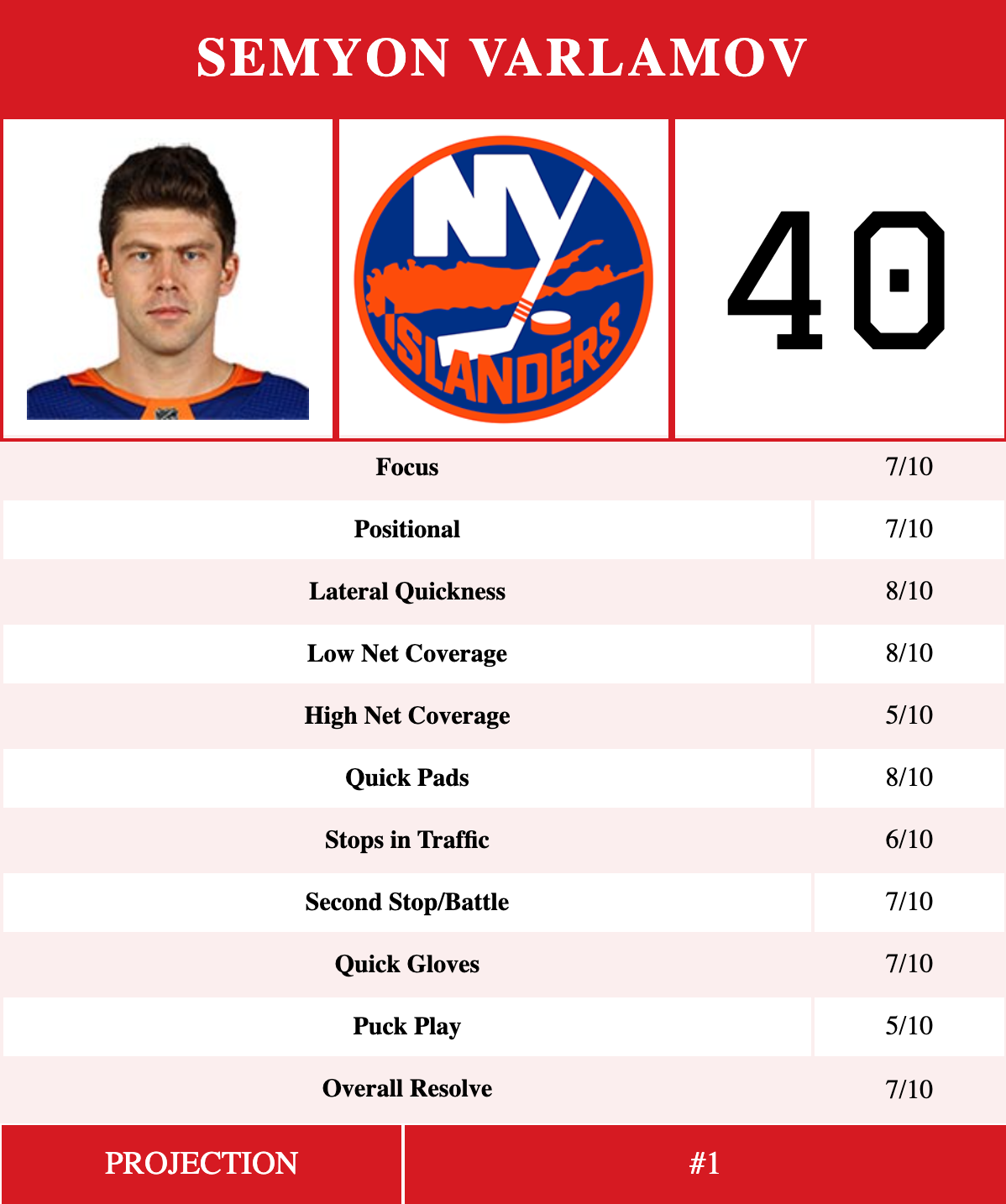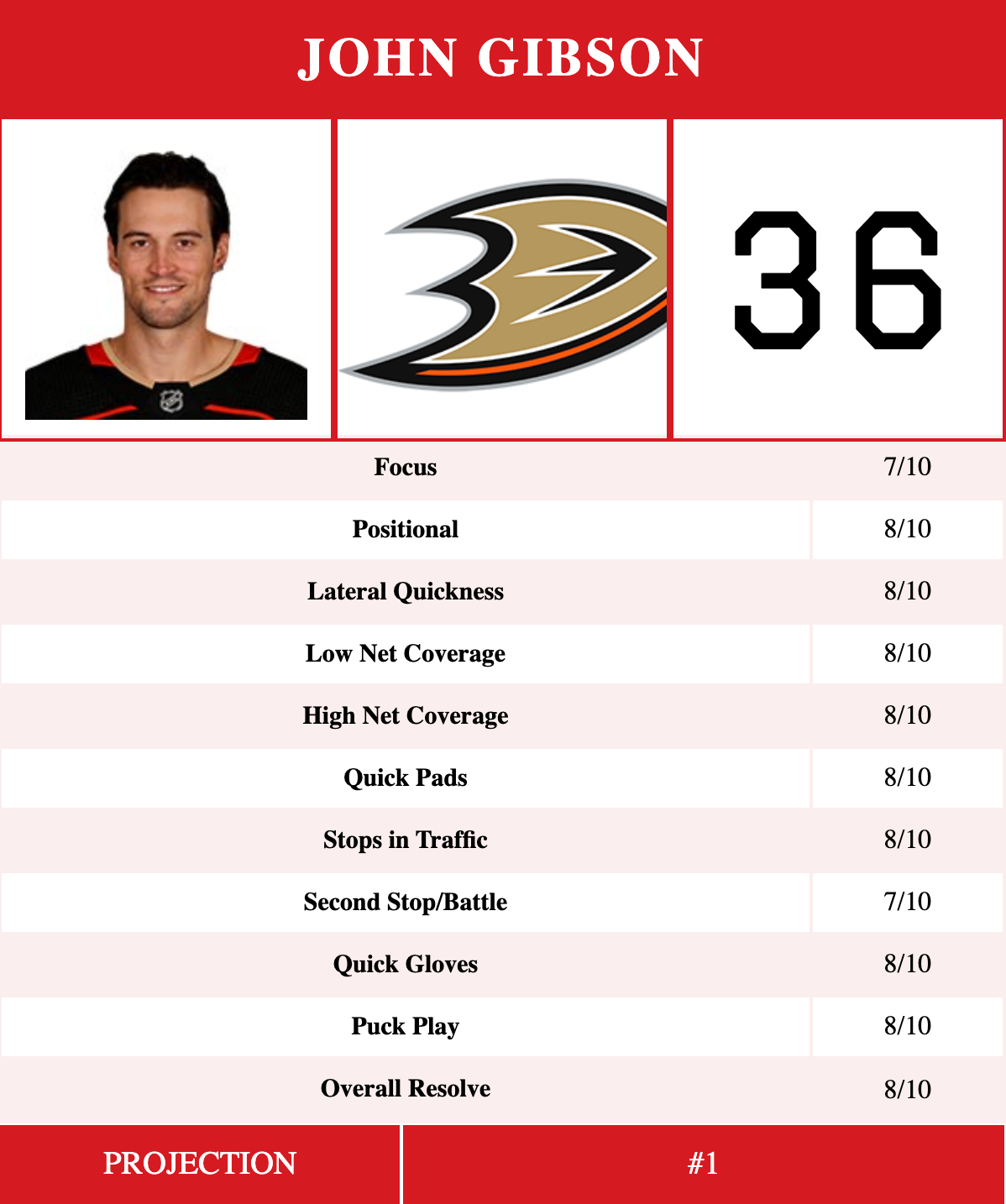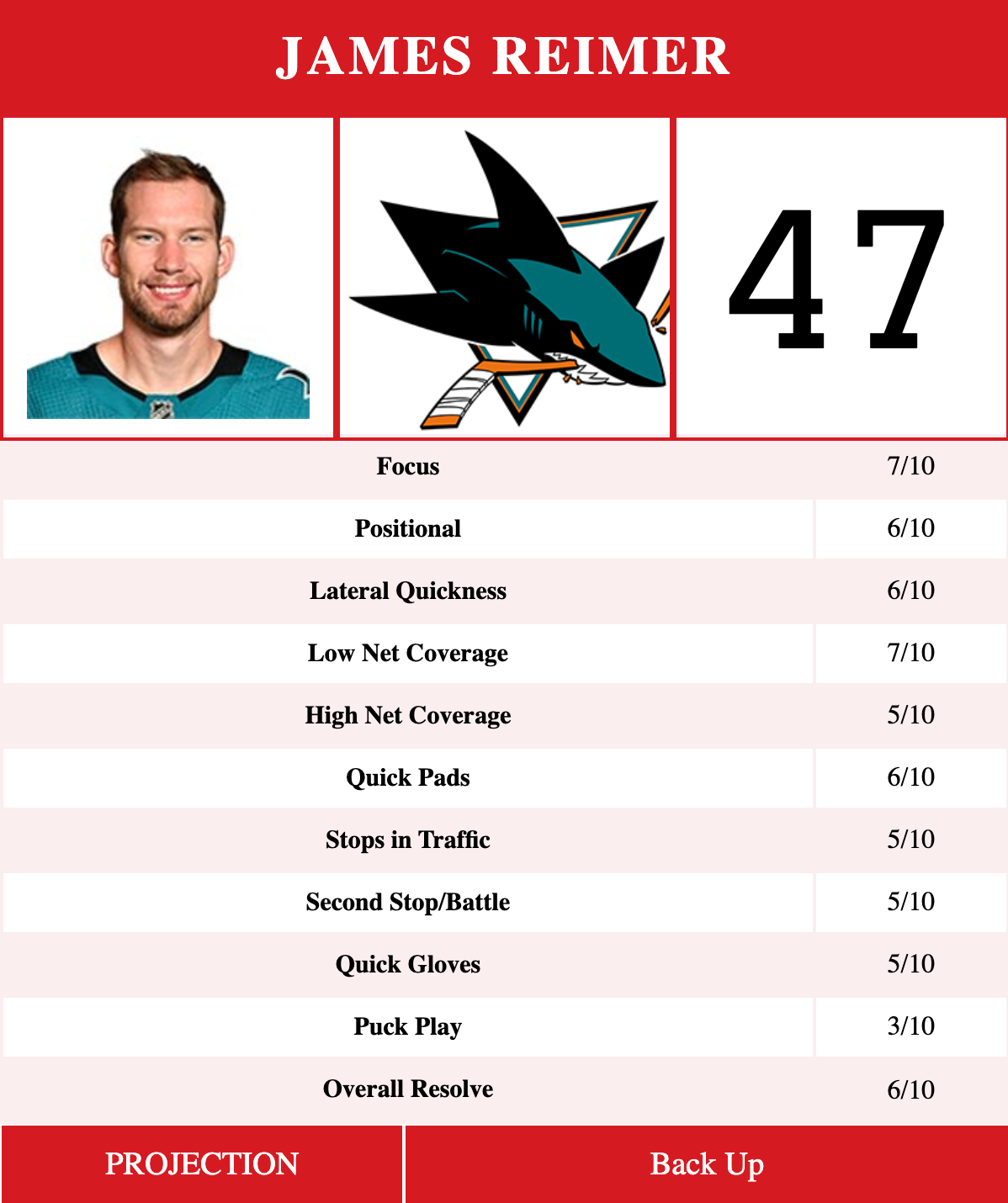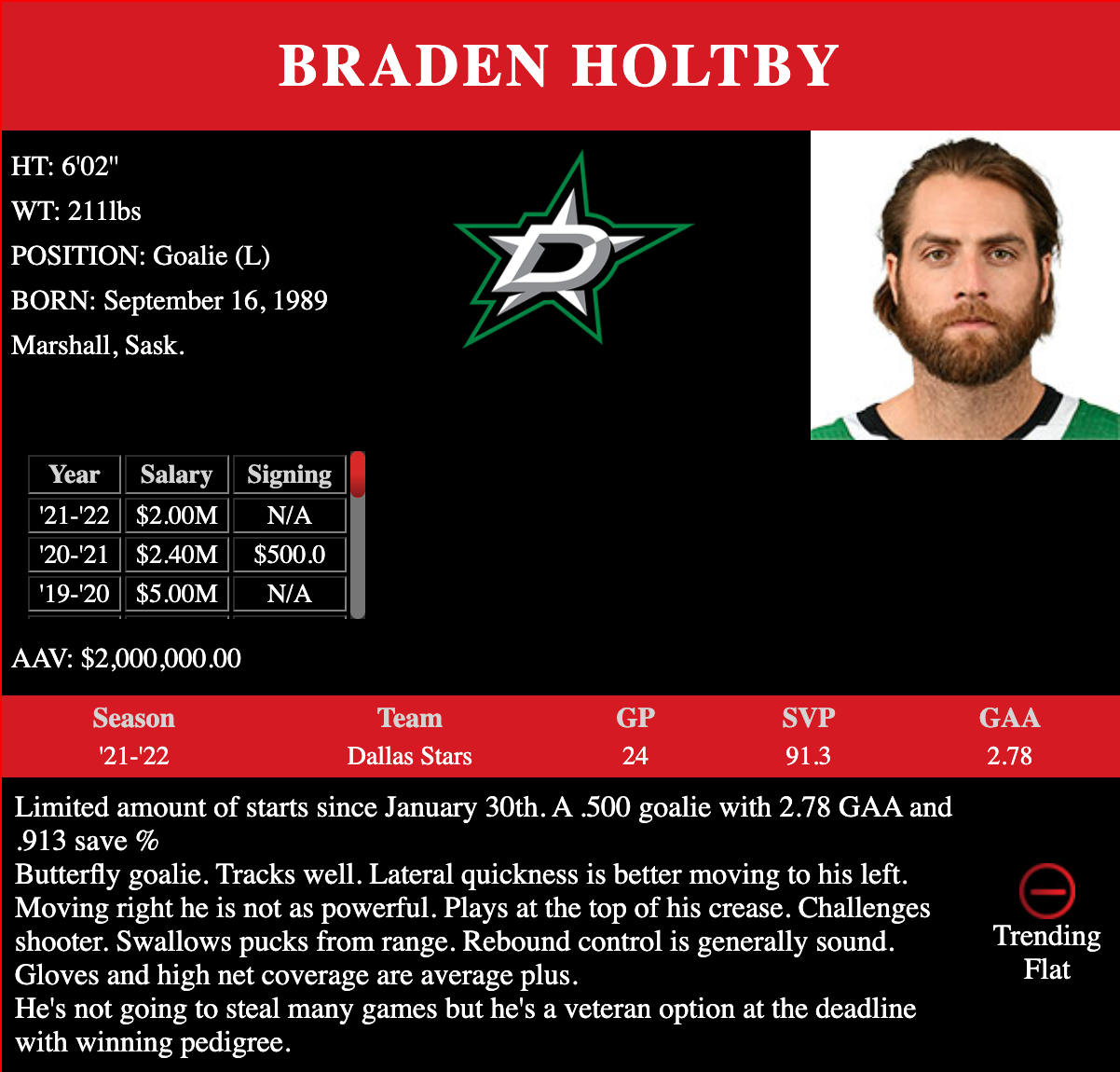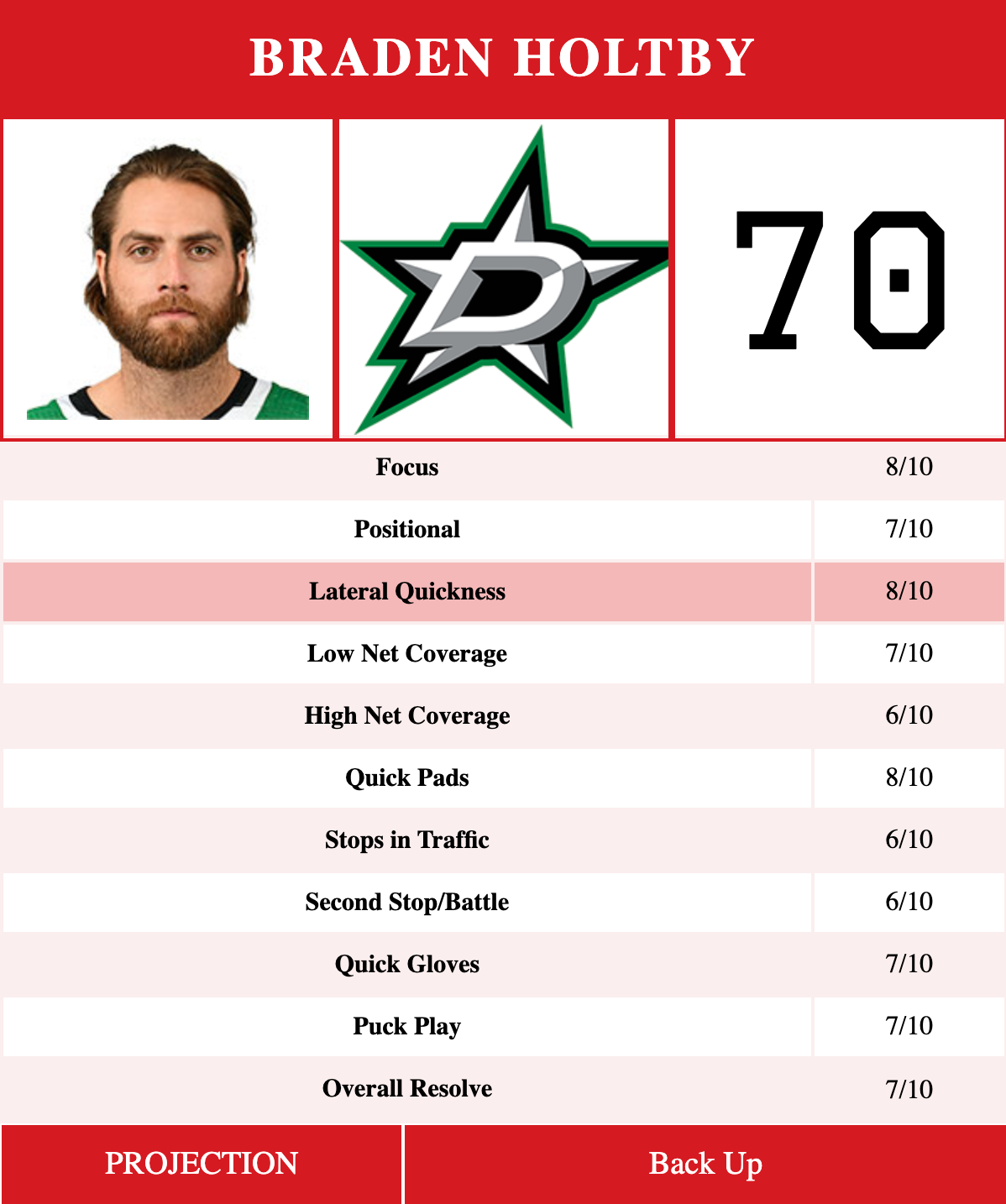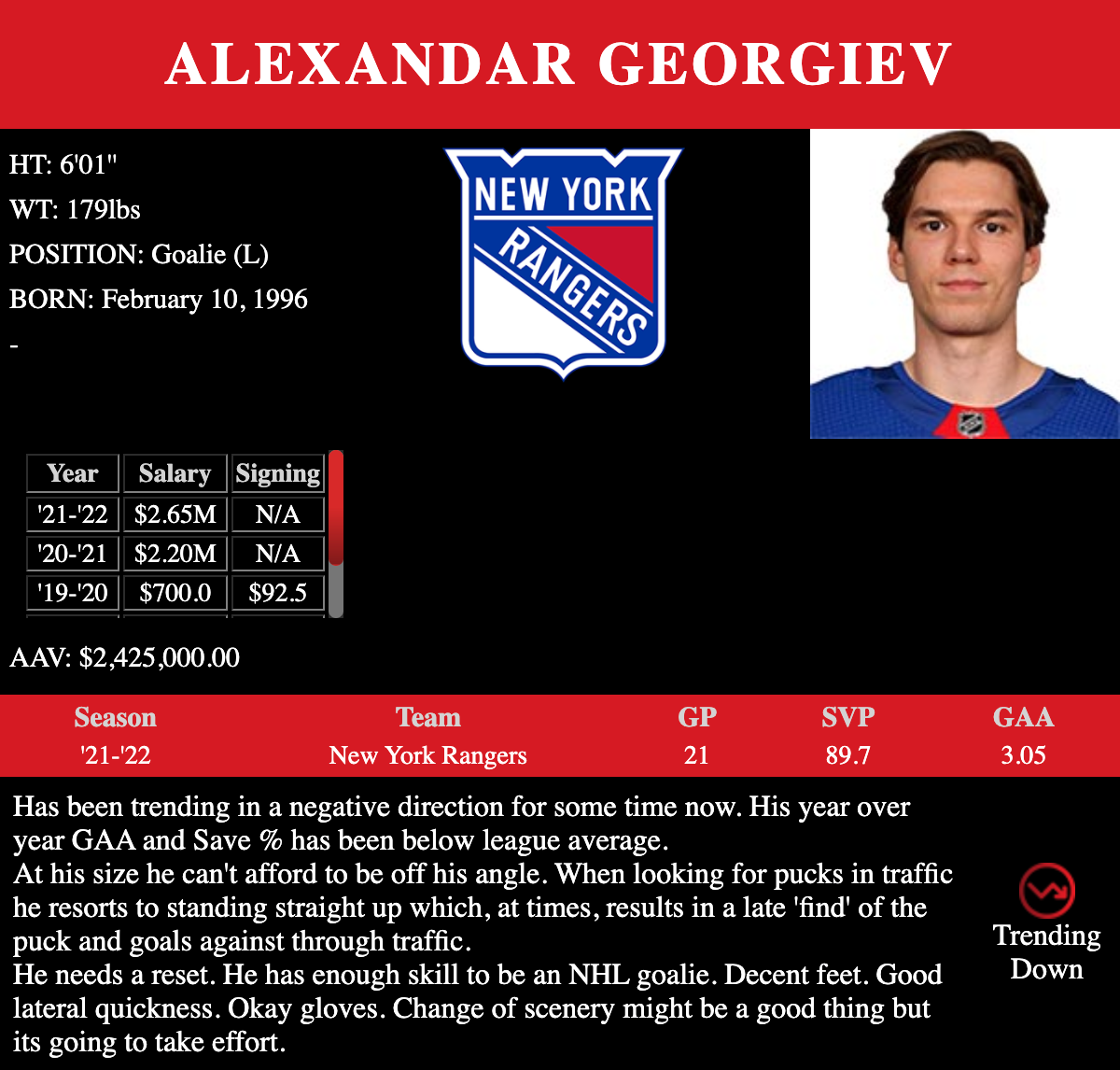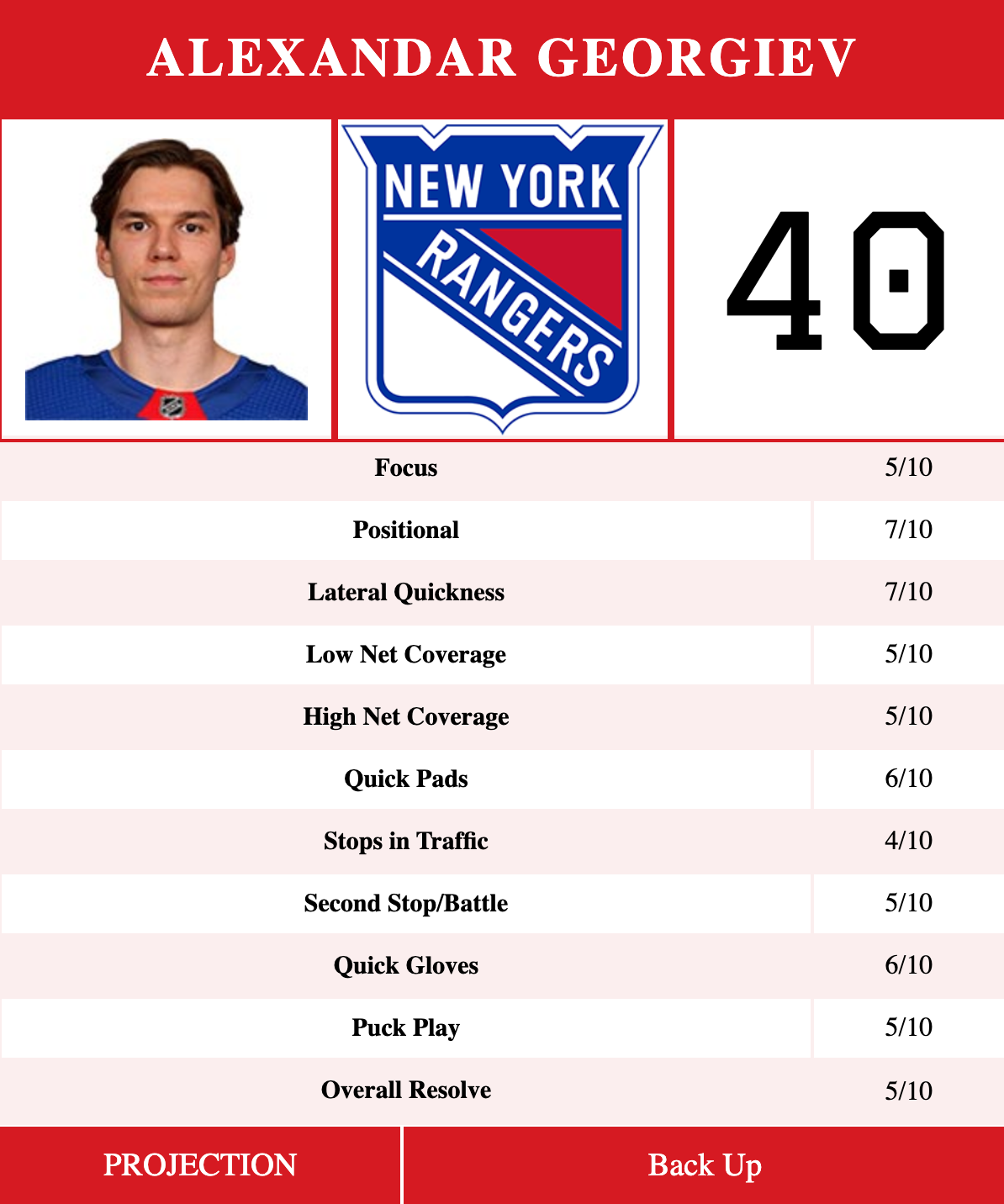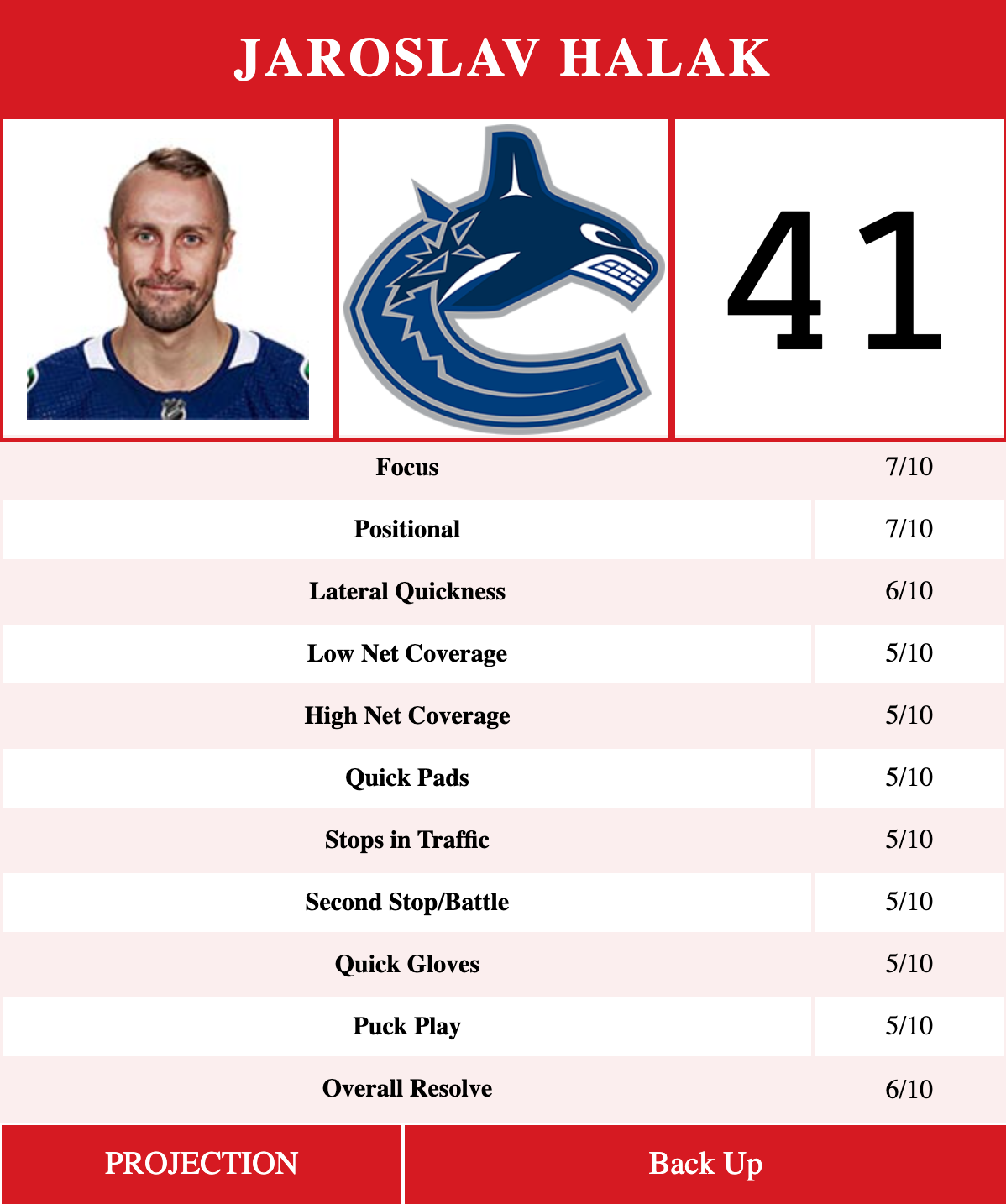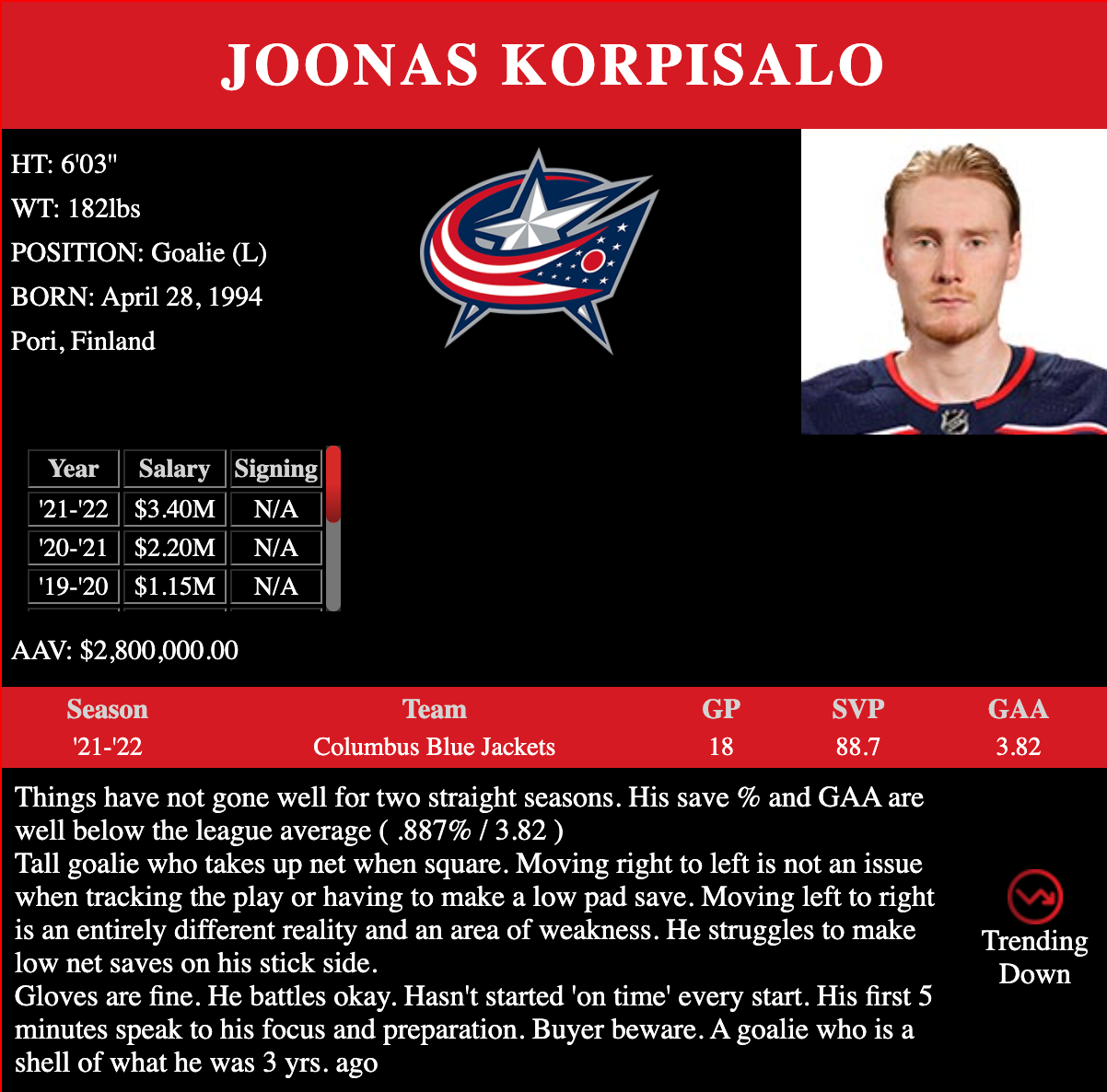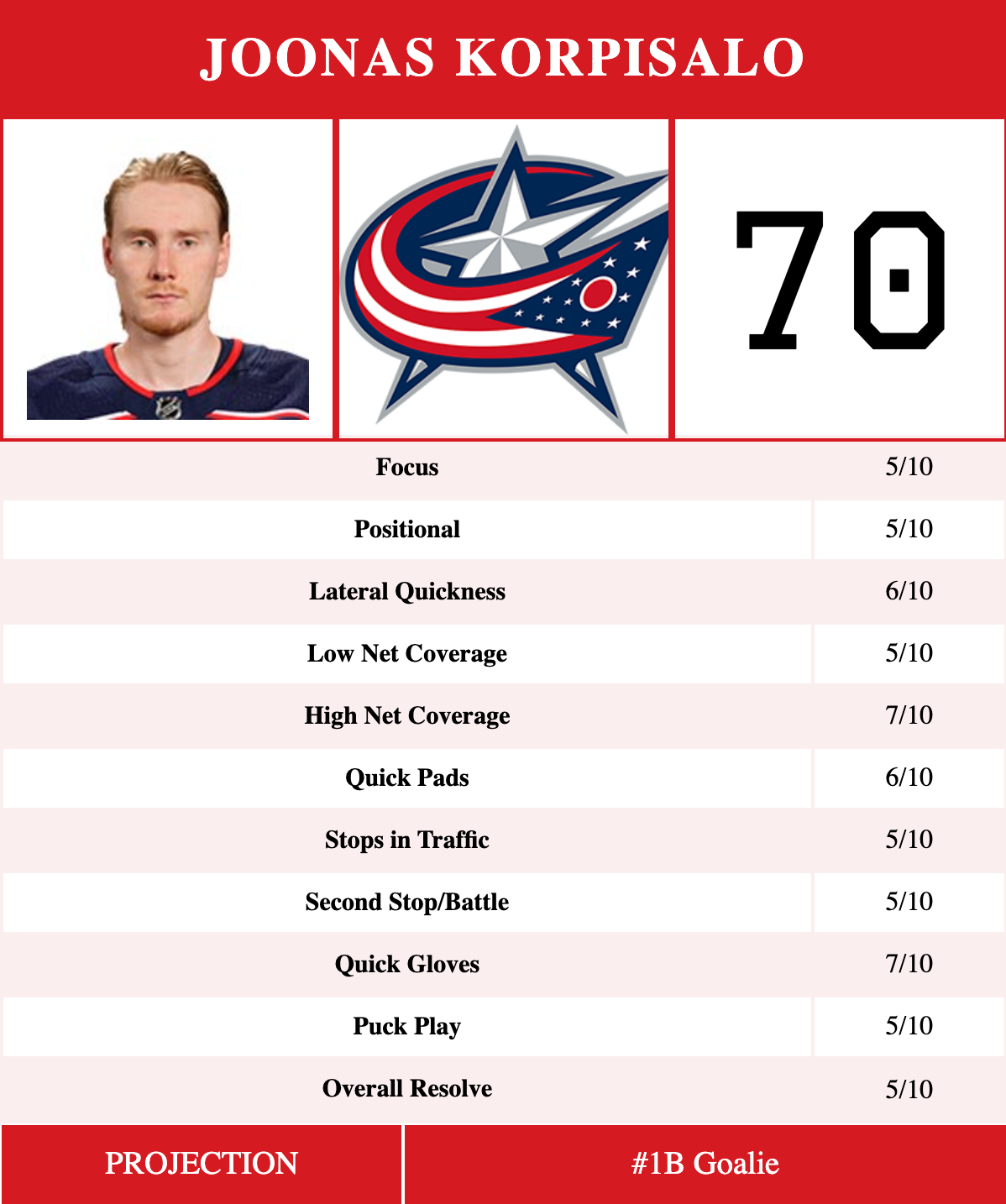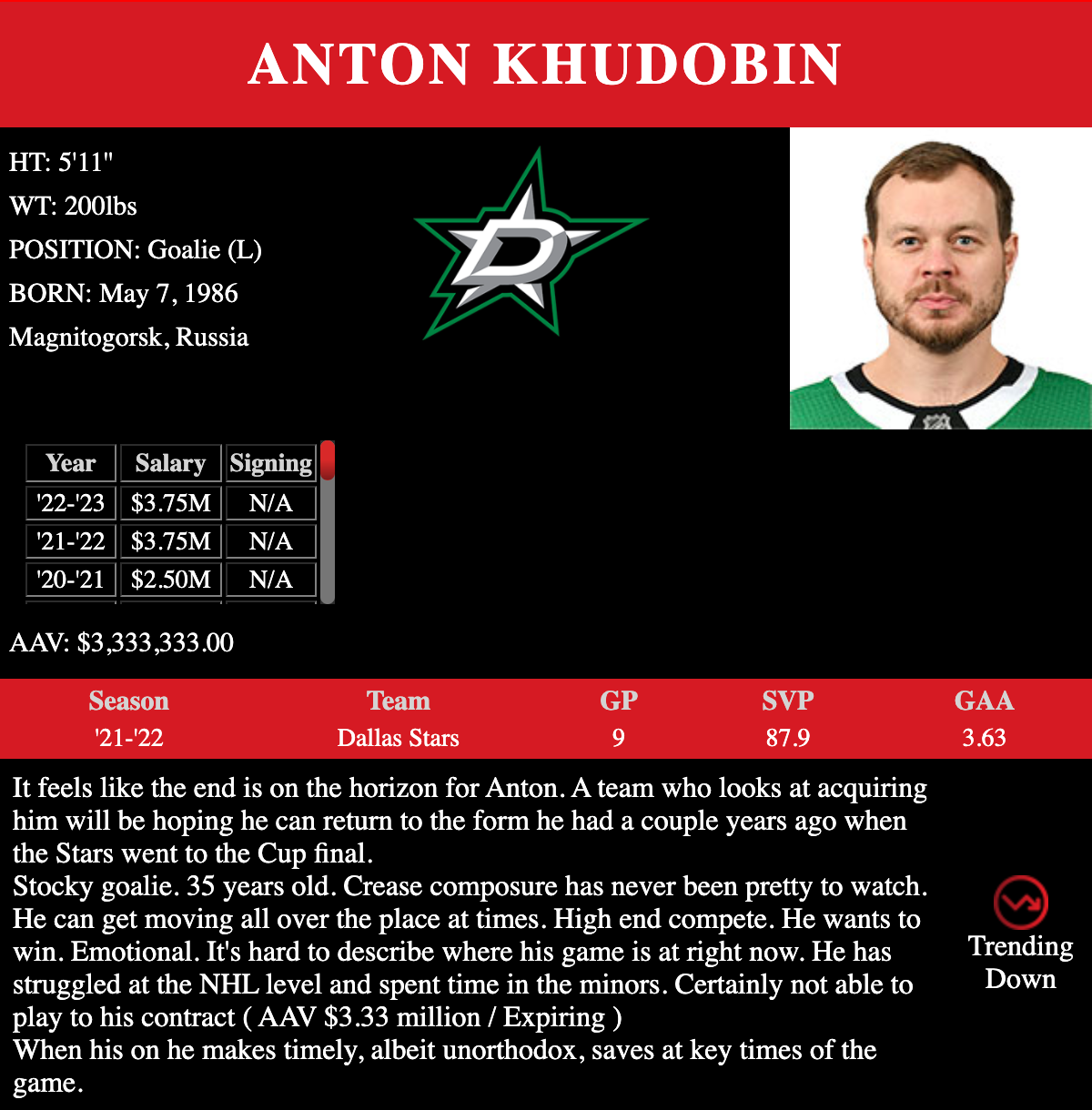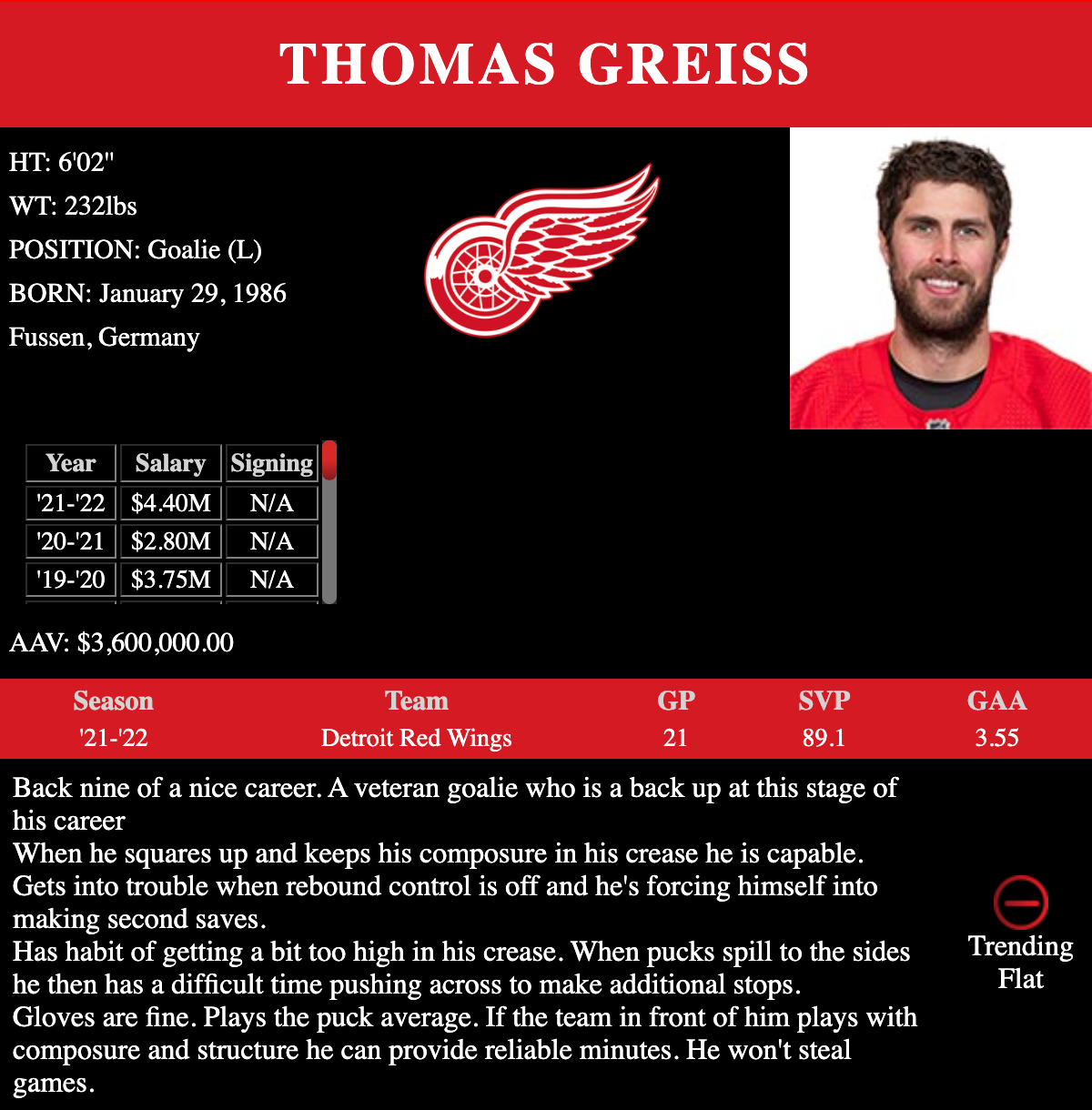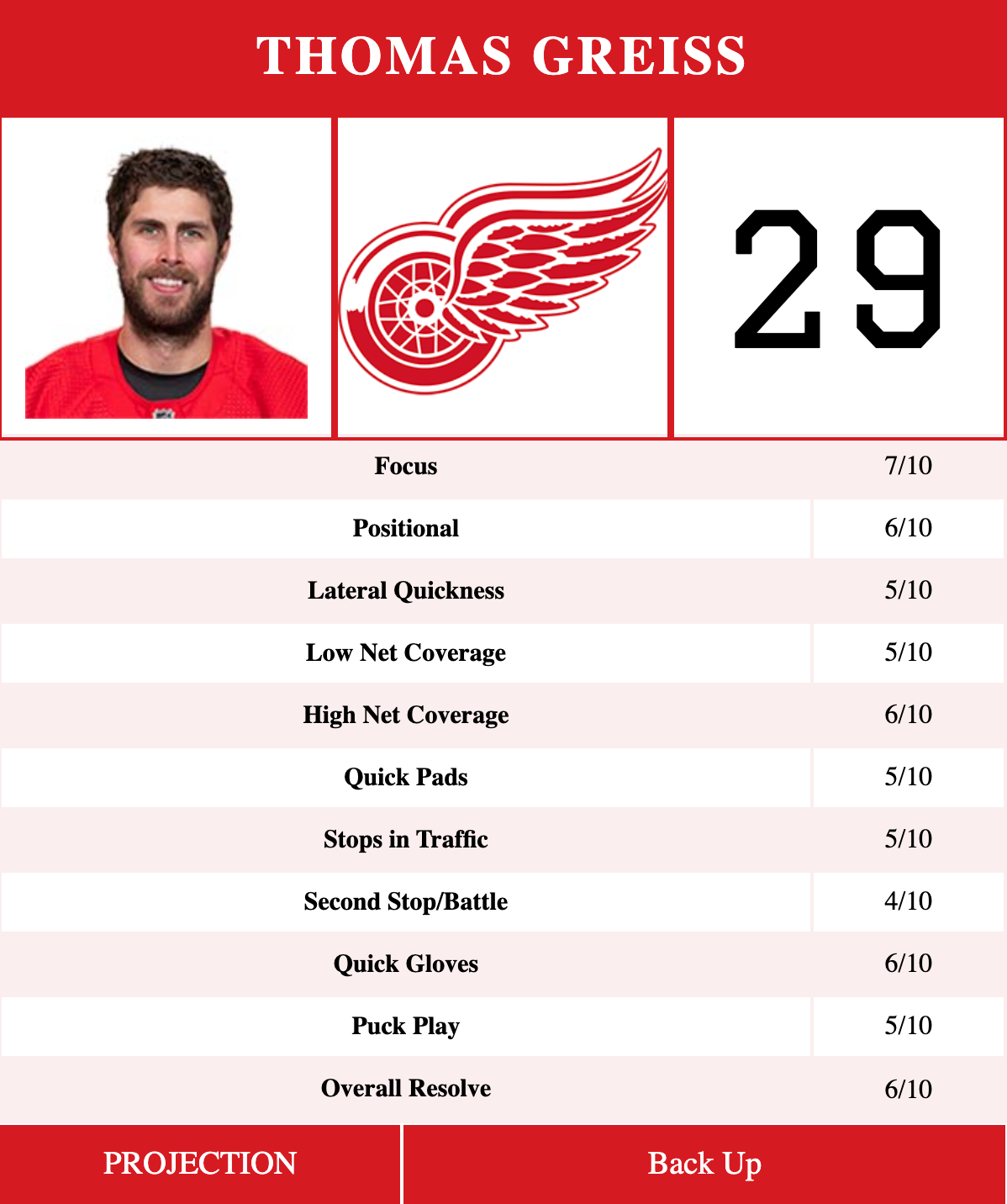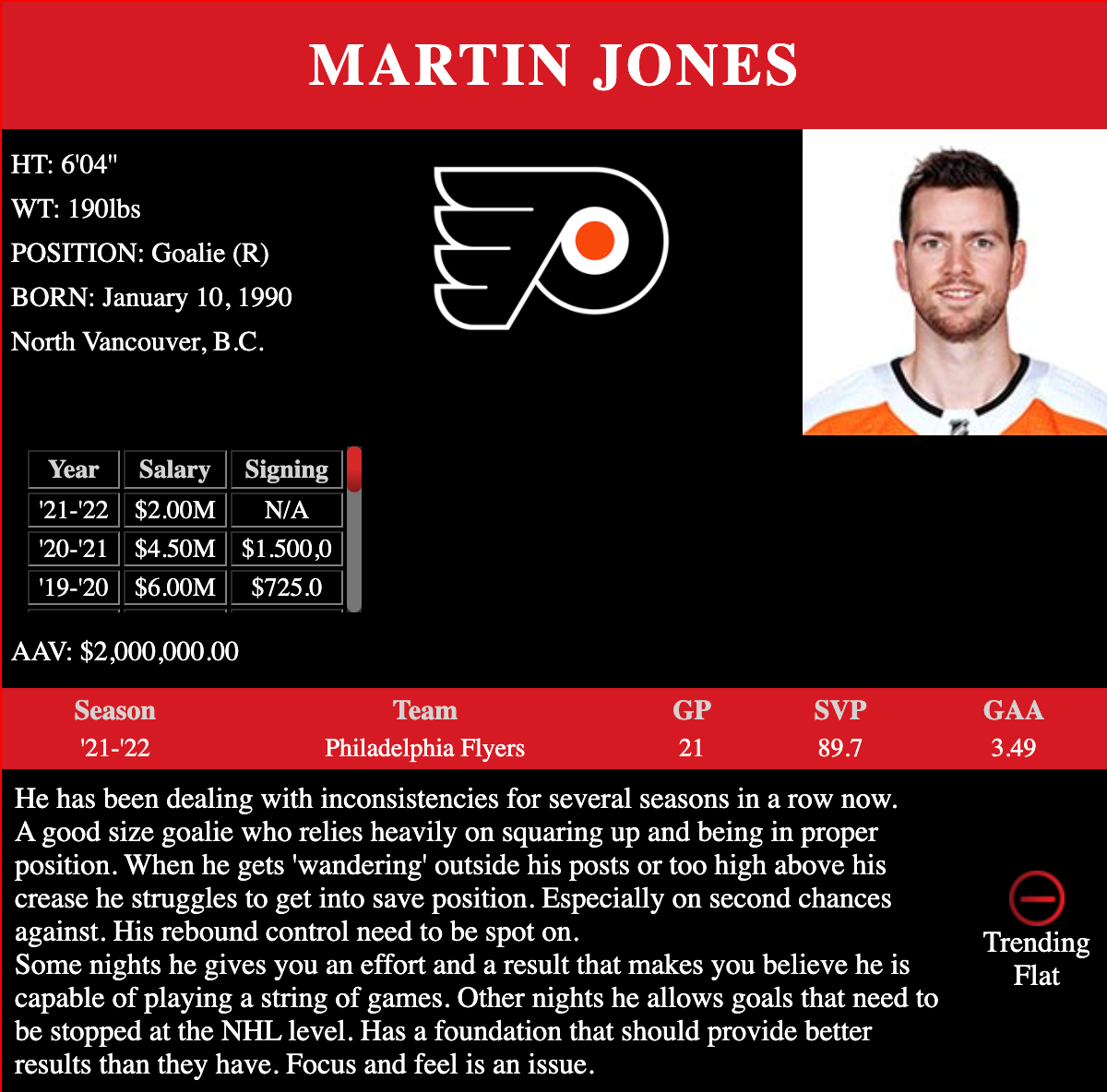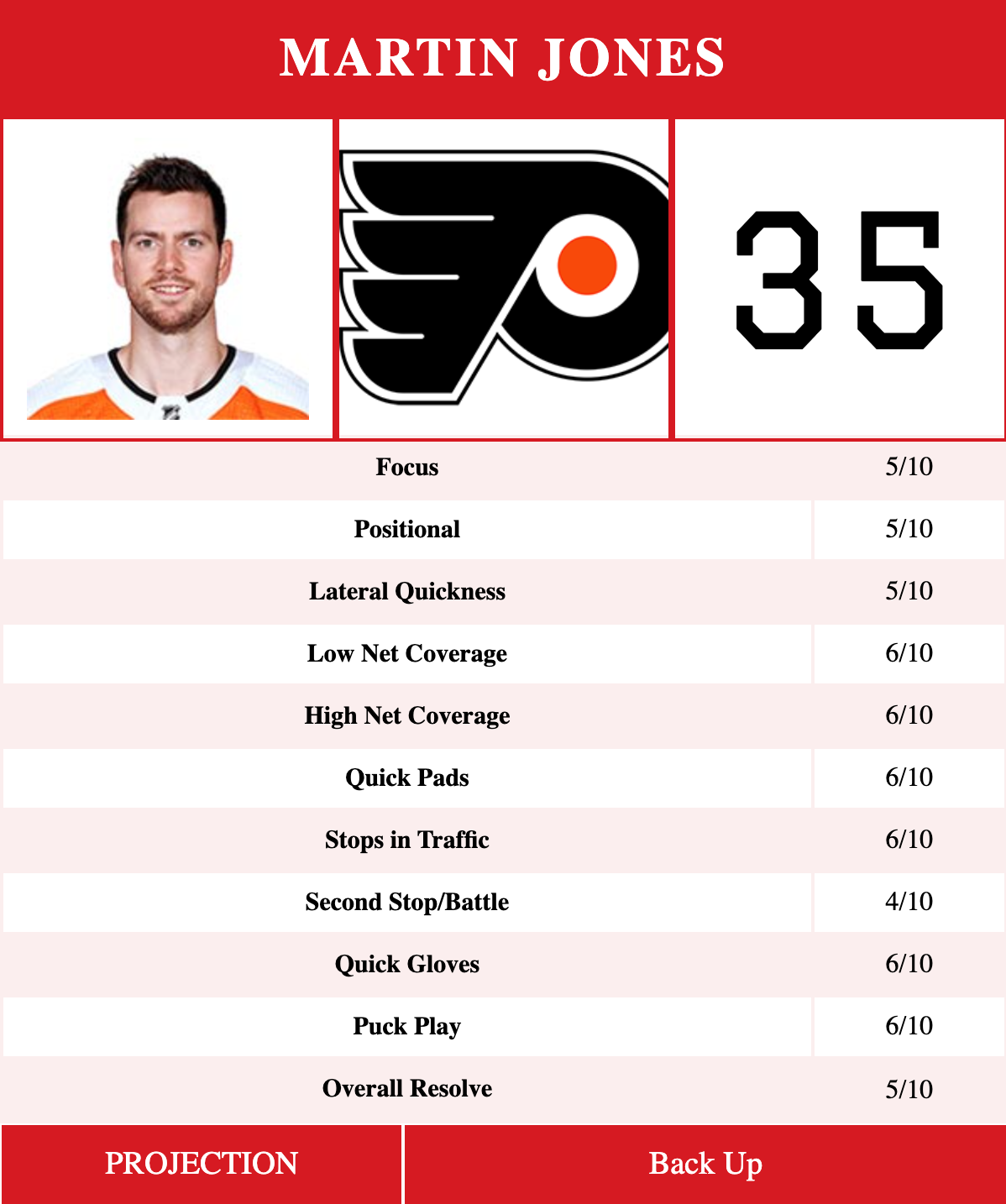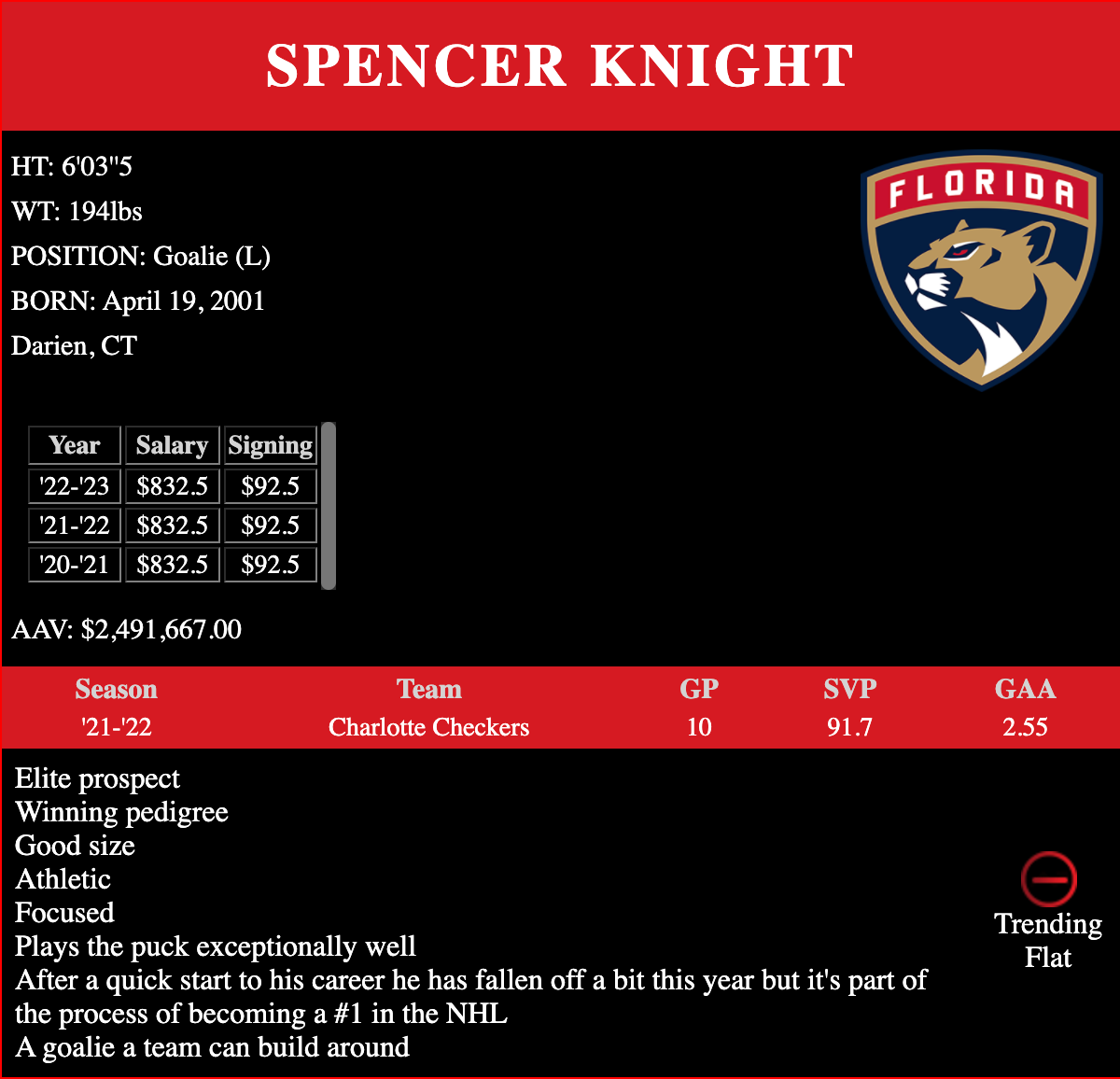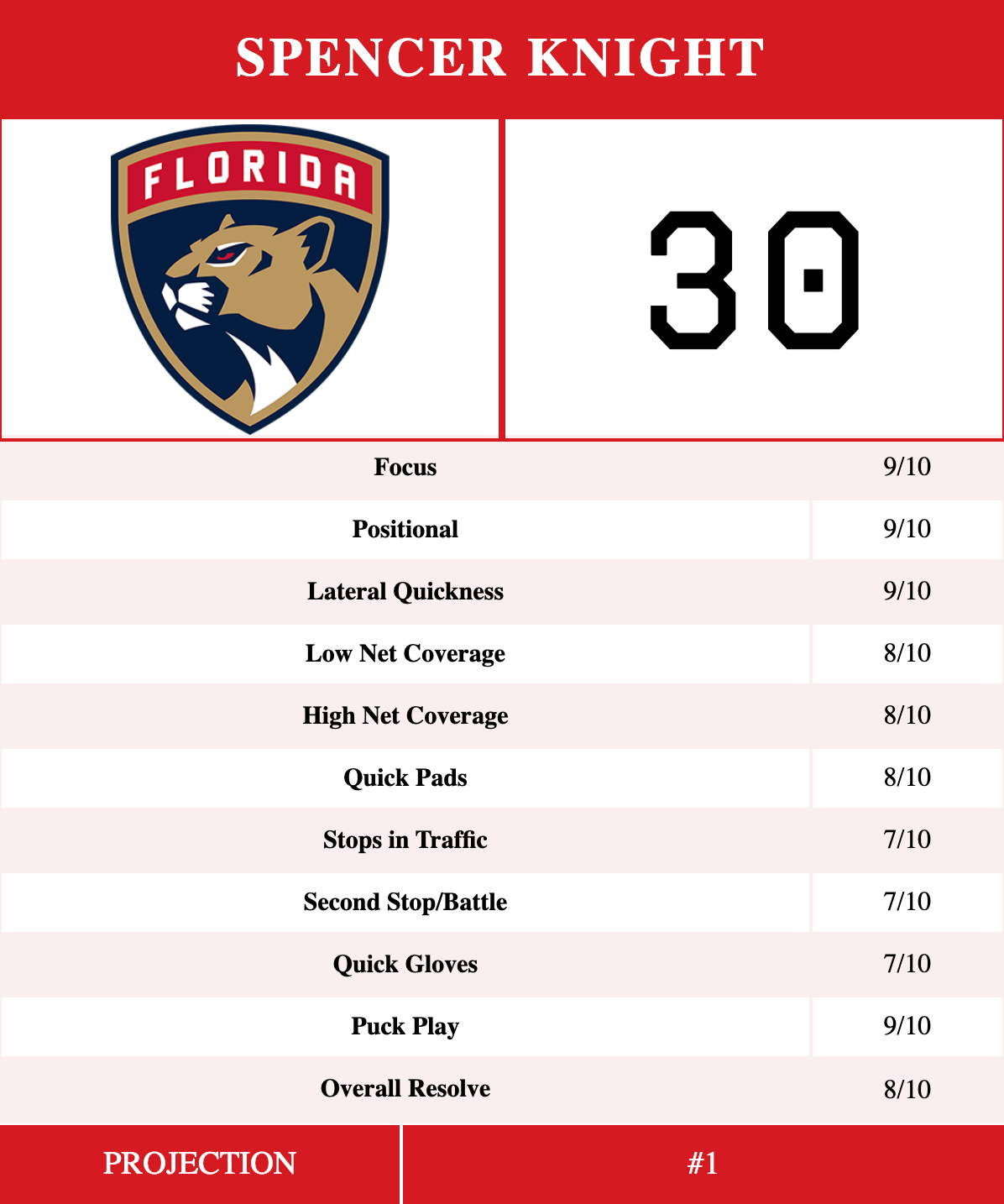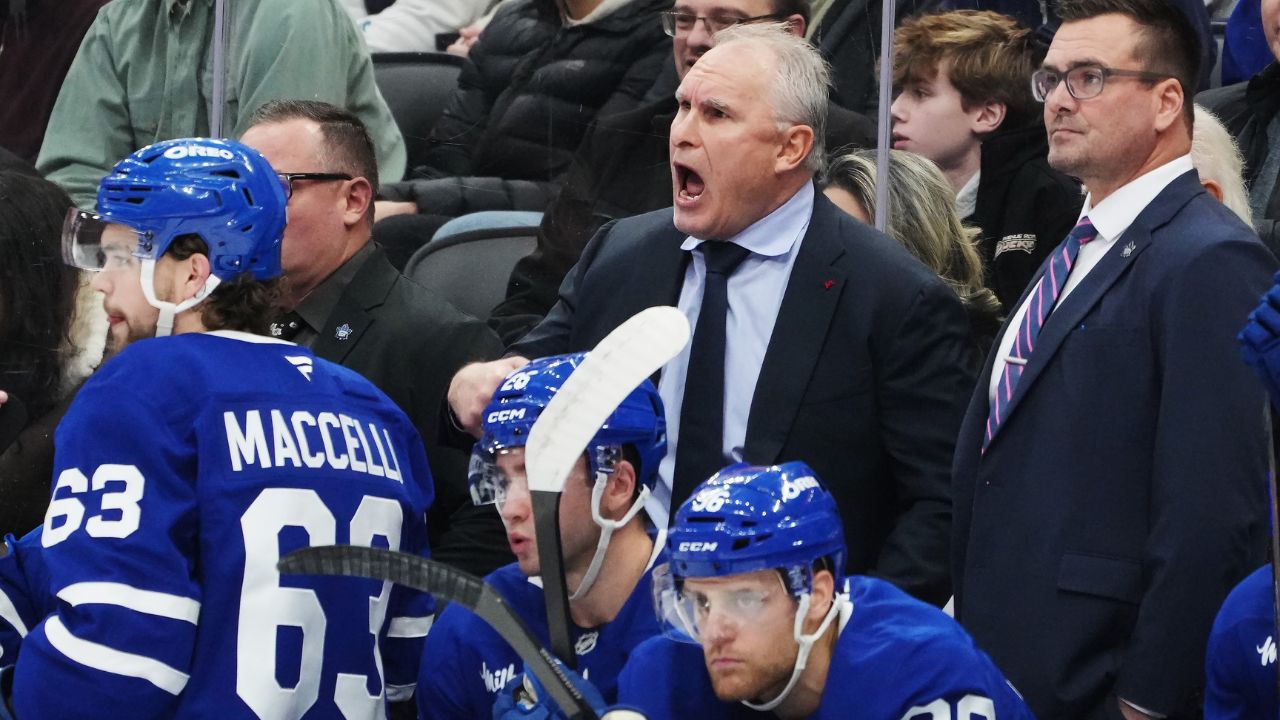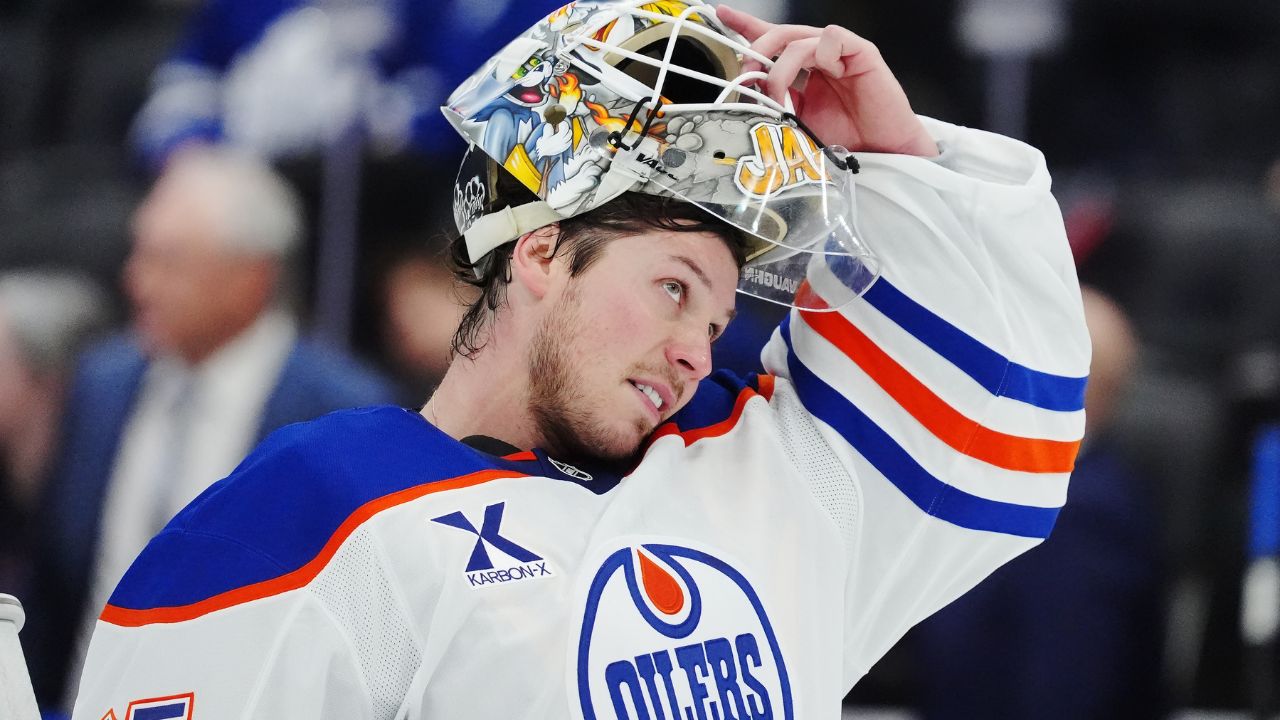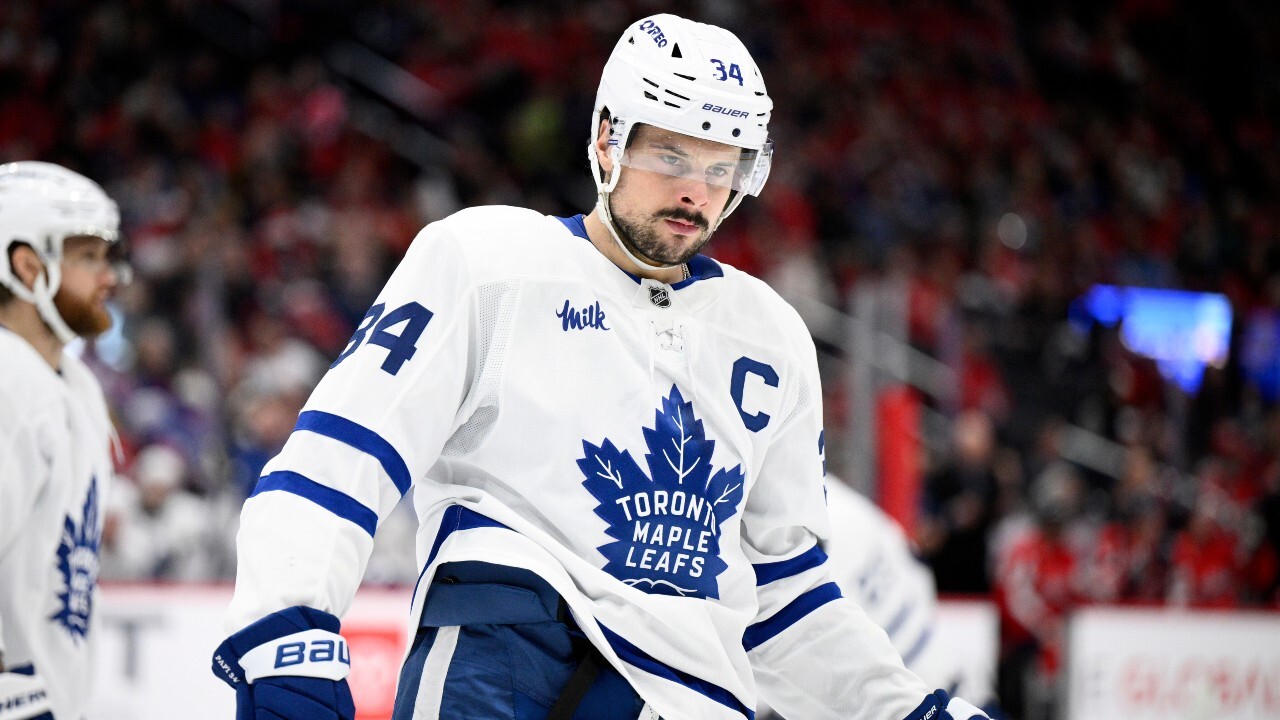
When it comes to the NHL trade deadline, most of the deals we’ll see will be for forwards and defencemen. We’ll see rentals moved. We’ll see top-six players added up front, and gritty players to the depths of rosters. There are a couple top-four defencemen who could be had, as well as a number bottom-pair or No. 7 players.
There are many possibilities, both big and small.
But what about the goalie market?
It’s the position that can bring the most panic to a fan base if there’s even a short stretch of instability. Subpar goaltending can sink your playoff hopes even if every other part of your team is clicking. And yet, it may be the most difficult to address, certainly in-season.
The goalie trade market is the least defined of all the positions. While the last three deals made in the NHL all involved goalies, we’re talking about three guys unlikely to see much action: Alex Stalock, Michael McNiven and Carter Hutton. And the more impactful goalies moved over the past two years haven’t exactly brought back home-run returns.
In September of 2020, Jake Allen was traded to Montreal for a third-rounder and two sevenths. At the 2020 deadline, Robin Lehner was sent to Vegas for Malcolm Subban, a prospect and a second-round pick. And just a couple of weeks before that deadline, the Leafs picked up Jack Campbell (and Kyle Clifford) for Trevor Moore and a couple of third-rounders. And, of course, just last off-season Marc-Andre Fleury was salary-dumped to Chicago for a middling prospect. His salary, and Vegas’ inability to retain any of it, certainly affected that return.
Heck, even Alex Nedeljkovic, a 25-year-old at the time coming off a Calder finalist season, returned only Jonathan Bernier and a third-rounder to Carolina.
With the exception of the Darcy Kuemper trade to Colorado last summer — where the starter-desperate contender gave up Conor Timmins and a first-round pick — we wouldn’t call this a seller’s market.
The other dynamic here is that, if you want to find a value goalie to play the role of backup or work in tandem with another on the roster, you probably have a better chance of doing that in the off-season. Rather than the trade market, the game of goalie musical chairs generally happens through free agency. Why, just last summer we saw Frederik Andersen take a paycut to $4.5 million on a two-year deal with Carolina. The Bruins replaced Tuukka Rask with Linus Ullmark through free agency. How many of the goalie-needy teams now would like either of them in hindsight?
If you can wait until the summer to address your situation in net, you probably do. A number of the names listed below will be available to sign in July. On top of that, Campbell and Kuemper are both slated to be UFAs and, along with Fleury if he continues his career, could be No. 1 upgrades for someone. But you’ll be hard-pressed to find many options who tick that box right now.
There are certainly teams with questions in net right now. Minnesota, Edmonton, Toronto and Washington immediately come to mind as potential destinations for the top available goalies. But how realistic is it to really improve through this year’s trade market? There may not be a heck of a lot to choose from that would make worried fans sleep better at night.
Two weeks from the deadline, with goalie worries escalating in these markets, here is a tiered look at the goalies who may be available in the right scenario.
TOP CANDIDATE TO MOVE
Marc-Andre Fleury, Chicago Blackhawks
Long thought a certainty to be moved by the deadline, there is now some doubt beginning to sprout around his availability. Though Fleury has a partial no-move clause, the Hawks have reportedly assured him they won’t send him anywhere he doesn’t want to go. In 32 Thoughts last week, Elliotte Friedman wrote about the situation: “I’m not sure he’ll want to go anywhere unless it is a serious contender.”
As to which teams could be interested in Fleury, the Washington Capitals were the first one to pop up earlier in the season, though his past as a Penguin seemed to make that unlikely.
“I am not convinced that Fleury would be comfortable doing it,” Friedman said on The Jeff Marek Show in January. “He’s still very much a Penguin and I think sometimes we underestimate how much passion there is in these rivalries.”
That was over a month ago and ever since the Capitals are 7-7-0 and trying to keep space on Columbus for the East’s second wild card. Vitek Vanecek has been just fine for them and may be able to lead them through, though GM Brian MacLellan confirmed last week his desire to add a veteran to the crease. But we have to wonder in regards to Fleury: while the Caps still want to address their goalie situation by the deadline, would they even qualify as a “serious contender” anymore?
The Edmonton Oilers are another team that could look to address its netminding situation, likely needing to send Mikko Koskinen out as part of the deal to drop salary. But, again, you have a team with a questionable Cup outlook and a recent playoff history of utter disappointment.
Toronto? Concerns in that net grow by the day, but they may want to help their depth and impact at forward or defence instead. GM Kyle Dubas just last week shot down suggestions he was wading into the goalie market and acknowledged his desire to focus on the blue line instead.
Colorado, linked to Claude Giroux mostly, was part of the goalie discussion for some time, but lately Kuemper has been giving them the performances they acquired him for. His .926 save percentage since Dec. 1 is seventh among goalies with at least 10 starts and he’s 18-1-2 in that time.
Minnesota, perhaps, is one place where team need and quality align to make an interesting fit for Fleury. Cam Talbot and Kaapo Kahkonen have made 15 starts between them since Feb. 1 and allowed four goals or more in a game in 10 of them. Talbot, the starter, has allowed four goals or more in each of his past five starts. But, if they push chips in ahead of significant buyout cap penalties next season, will it be for a one-year goalie rental? The Wild will need their picks and prospects for their next phase.
The idea of a Vegas return for Fleury was floated, and then shot down.
The point is there doesn’t appear to be a lot of perfect fits for a player who may not be all that motivated to move anyway. There’s still time two weeks from the deadline, but it’s quite possible the biggest potential difference-maker at this position doesn’t move at all. Would be a shame for all of us hoping to see Fleury in the playoffs again.
Scout’s Analysis: “Has ability to steal games. Playoffs do not intimidate him. Best available goalie. Proven winner. Vezina Trophy winner, Stanley Cup Champion.” – Jason Bukala
UNLIKELY, BUT BIG MOVE POTENTIAL
Semyon Varlamov, New York Islanders
There are probably more reasons for the Isles to keep Varlamov than to move him. A playoff push is out of reach this season, but it was a strange one for the team that included some unique challenges. This, after back-to-back Round 3 playoff appearances. Throw 2021-22 out and the Islanders could return to something close to that form in 2022-23. Even with Ilya Sorokin confidently taking over for the (likely) longer term fit here, having the security of two capable goalies for one more season could be valuable.
GM Lou Lamoriello recently acknowledged that some individual performances haven’t been up to expectation this season, but also told The Athletic’s Kevin Kurz he has “a real strong belief in this core.”
As discussed above, the goalie market isn’t a particularly well defined one either. The Isles would have to get something in return for Varlamov that notably improves them in some way going forward and it’s not obvious the in-season trade market could bring it.
Still, we wonder if the conditions could ever be right. Sure, having two goalies is nice, but if Sorokin stays on track, Varlamov would seem likely to walk as a UFA in 2023. If the right return could be found from a motivated buyer — and that’s key to any deal — the Islanders may find a better value through free agency than spending $5 million against the cap for a 1B/backup.
If Fleury doesn’t want to change teams, Varlamov would become the best potentially available at the position. And while Fleury would be a rental, Varlamov is signed for another season, inflating his value even further. Does this encourage any potential buyer to spend up, or is the market for the higher end goalies just not going to be ripe enough?
Scout’s Analysis: “It’s neck-and-neck with John Gibson for the No. 2 “best available” option in a trade scenario. I’m leaning Varlamov. It’s been a tough year for the Islanders. He hasn’t personally won a start since January. I’m not holding him personally responsible for the losses, however. The team has scored a grand total of 11 goals in his last seven starts. Eleven! His salary structure makes more sense than Gibson’s. Varlamov’s at worst a 1B option. Change of scenery might do him some good. Don’t be surprised to see him go on run of wins if it happens.”
John Gibson, Anaheim Ducks
It feels like Gibson has been orbiting the trade rumour well for a few years, but always from a distance. Same thing now. Are the Ducks likely to trade him? Probably not. Even if you want to count them out in 2022, the Ducks are putting their rebuild pieces in place and could be in position to see more meaningful progression soon. The last thing you’d want is to leave a weakness in net now, and there is no clear or immediate replacement for Gibson in the organization.
Gibson’s numbers suffered the past two years as the Ducks sagged, and he was recovering to some degree this year. Since the all-star break, however, Gibson has been awful. Probably just a blip, though not the most inspiring thing if you’re trying to settle your goalie position through trade right now.
Of course, if you’re trying to get Gibson, his past seven outings don’t carry too much weight because this would be a long-term investment. Gibson makes $6.4 million against the cap through 2026-27 and, at 28 years old, should have a few good years left. That increases the cost of acquisition and will likely be a bridge too far.
It’s still worth noting Gibson here because a) Anaheim is set up to potentially be the deadline’s most interesting team and b) they have reportedly been careful in committing term to any of their pending UFAs, wanting lots of flexibility moving forward. Gibson’s is the longest term deal on the books.
Scout’s Analysis: “Health/durability have been an issue. When he’s on, he can steal a game. Risky acquisition due to injury history.”
TANDEM/BACKUP OPTIONS
James Reimer, San Jose Sharks
At 33 years old, Reimer is one of those goalies who absolutely could find a hot-streak moment and run with it. A slightly above average goalie for the past couple of years, Reimer has been pretty good for the Sharks this season but with a few hiccups. His .916 save percentage is the best it’s been since 2016-17 and his 7.64 Goals Saved Above Average via Hockey Reference is 15th in the league. At $2.25 million, he’s a great value as well, and signed for another season at that rate.
There’s an argument to be made that Reimer is the best potential value available on the goalie trade market.
The Sharks are out of it this season and will be evaluating to what degree they need to change over the roster and how far they have to dip in the rebuild waters. On the one hand, Reimer is almost guaranteed to bring value again next season and could still be dealt as a rental in 2023. On the other, if the Sharks can get a slightly better return selling him now, they might be able to find an affordable replacement through free agency.
Reimer is week-to-week with a lower-body injury right now, which will muddy his situation a little more.
Scout’s Analysis: “Only 33. Seems like he’s been around forever. His game has been solid. Does he have mindset to win in playoffs?”
Braden Holtby, Dallas Stars
Holtby’s has been a name mentioned in the goalie market for some time this season, probably even before Jake Oettinger took over the crease. Between Oettinger, Holtby and Anton Khudobin, the Stars have one more NHL goalie than they need.
Behind a better team defence in Dallas, Holtby’s season-long numbers are improved so far in 2021-22, though it should be noted much of that is due to a strong start. Since Dec. 1 he has a .901 save percentage and lost the crease to a surging young Oettinger.
Here is where the tier breaks because you’re ideally not acquiring Holtby to be a No. 1 goalie who saves your season. Rather, Holtby is a 1B or veteran backup to give you piece of mind for cheap (in assets and salary) the rest of the season. Of course, that could be exactly why the Stars could keep him (and/or Khudobin) now that they’ve retaken a playoff position as one of the hotter teams in the league.
Scout’s Analysis: “Not a ton of games this year for a variety of reasons. Has bounced back however and looks closer to his old self.”
Alexandar Georgiev, New York Rangers
It hasn’t been the best season for Georgiev who is well, well out of the goalie picture for the Rangers now. His save percentage has slipped a little more every season since his 10-game 2017-18 debut, though it’s worth noting he’s in a tougher situation now than perhaps ever before.
Georgiev once had promise to be at least a tandem option, if not a starter, in the right situation. He at least deserved the shot. In New York, Igor Shesterkin was always the plan, and he’s arrived with a season so good he could win the Hart Trophy. So after Georgiev was building his resume for a few years, he’s now used almost exclusively in back-to-back situations and has no chance of settling in to a routine.
This isn’t a situation where the Rangers will get a big return, and maybe not even a particularly notable one. Would a late-round pick or two do it? Georgiev will be an unhappy RFA this summer and seems replaceable for the Rangers. And while, sure, they might see value in keeping the backup, this is a team that will be done if anything happens to Shesterkin. If it comes to that, will Georgiev be able to take this team any further than Keith Kinkaid?
So why trade for him? An acquiring team would be getting a 26-year-old with a chip on his shoulder and a controllable contract for at least another season. He used to have more promise than he does now and if given a fresh opportunity, maybe there’s still potential to recoup.
Scout’s Analysis: “In need of a fresh start. He looks like he has lost his focus and confidence. A risky trade deadline pickup if team is looking for goalie to come in and make saves now. Needs to be rebuilt.”
Jaroslav Halak, Vancouver Canucks
If you figure it’ll take 94 points for the Canucks to get into the playoffs, that means they’ll have to win roughly 15 or 16 of their remaining 25 games. They have five back-to-back game situations over the remaining schedule, and without any time to spare, it might be nice to have a notable backup to step in and maybe steal a win or two.
Halak was supposed to be that safety net to keep Thatcher Demko rested. But as the Canucks have needed to lean on Demko to pull them back from a rough start to the season, Halak’s role has been diminished. Rather than being a 1B, Halak is on track to play fewer games in any full season he’s had since 2013-14 — and when he has gotten a start, Halak hasn’t earned himself more of them. He hasn’t even played enough minutes to qualify for our advanced stats group, and his GSAA of minus-7.22 ranks 58th out of 69 NHL goalies.
“Jaroslav Halak established himself as one of the best 1B options in the National Hockey League over the past 5-6 years, maybe even a little longer,” goalie guru and NHL.com writer Kevin Woodley told Halford & Brough last week. “But there’s a very fine line between 1B and every-two-week-backup. And he’s never had to be that guy.”
https://halford-brough-in-the-morning.simplecast.com/episodes/hour-1-the-canucks-didnt-lean-on-demko?t=27m20s
Halak has complete control of the situation with a full no-move clause and while a few weeks ago the feeling was that he may rather stay put, last week brought some suggestion that he may instead decide to go elsewhere for a playoff run after all.
Scout’s Analysis: “He looks checked out. Everything about his game is off right now. Team trading for him must be in desperate situation.”
HAIL MARY OPTIONS
Joonas Korpisalo, Columbus Blue Jackets
It has been another struggle this season for Korpisalo, who has been out of the lineup because of injury since the beginning of February. If he stays below a .900 save percentage, it will have been the fourth time in the past five seasons he’s finished that low. But, as a pending UFA, the Blue Jackets could seek to trade him for…anything.
Is Korpisalo even a backup you’d prefer to spend an asset on? That’s the question anyone is asking themselves and, perhaps, he’d be added to be a third-string “safety net” somewhere instead. There is not a lot of upside here and it’s not even obvious that Korpisalo would be an upgrade in a lot of situations.
Scout’s Analysis: “Buyer beware. He has been trending negatively for an extended period of time. Poor performances outweigh his good nights.”
Anton Khudobin, Dallas Stars
If Holtby is the veteran the Stars choose to keep for their run, maybe Khudobin is the one they could move for a draft pick or two. He’s already passed through waivers this season, which may indicate Dallas’ openness to it.
Khudobin got this team to the Stanley Cup Final just 19 months ago. This year he’s played just nine NHL games and posted an .879 save percentage. Injury, a busy Dallas crease, and taxi squad/AHL demotions have all been factors in a bumpy season for him.
At this point, the cost of acquisition should be very small, though his $3.33 million AAV would carry on to a pro roster next season as well. So while he might be an intriguing buy-low gamble you hope pays off if an emergency happens, the extra season could be a turn off in a tight economy. Even buying him out in the summer doesn’t make a lot of sense.
Scout’s Analysis: “Veteran who cares and competes. Nothing pretty about his style. A hot mess who stops pucks when he is on. Unfortunately he’s been way off this year.”
Thomas Greiss, Detroit Red Wings
Long an underrated goalie, Greiss is on an expiring contract now and not playing at his best this season. Sometimes veterans just hit a wall and experience a fall off they don’t recover from. You have to wonder if that’s where the 36-year-old is now.
In Detroit last season, Greiss posted a .912 save percentage and a plus-3.36 goals saved above average. This season he’s at .891 and minus-10.29 — it’s Greiss’ worst season of his career.
Like Khudobin, Greiss could be an insurance pickup for someone this season who only sees game action if something goes wrong. At most you bet on him as a backup. Unlike Khudobin, Greiss comes off the books this summer.
Scout’s Analysis: “Back nine of his career. A backup more than a starter.”
Martin Jones, Philadelphia Flyers
Not since 2017-18 has Jones finished a season with a .900 save percentage or better, currently sitting with an .897 save rate. At this point, we know exactly what he is.
Add Jones’ name to the list as another backup option who may instead be better fit as a No. 3 emergency for a contender. His $2-million salary comes off the books again this summer, so this is strictly a short-term thing. There is almost no game-changing potential here though. It’s more a question if the Flyers will be able to find a taker for the 32-year-old, given his play and the tight cap situations around the league. The Flyers would take any sort of asset for him, but is there a playoff team willing to invest cap space in Jones, even for only a few weeks?
Scout’s Analysis: “What version of Martin Jones do you get on a nightly basis? Risky acquisition.”
WILD CARD PROSPECT
Spencer Knight, Florida Panthers
Wouldn’t say this is a particularly likely player to be moved and certainly not one the Panthers would be itching to trade. Goalies can sometimes take a little time to fully develop into the NHLers they project to be, and so it would be foolish to overreact to Knight’s 20-year-old season in which he was demoted to the AHL for 10 games. Knight, the 13th overall pick in 2019, is still one of — if not the — best young goalies in the game with superstar potential.
So why move him? Well, Sergei Bobrovsky is still under contract for an additional four years and that’s a deal you won’t be able to separate from. So, the thinking might go, with the No. 1 job occupied perhaps Knight could be used to get an upgrade elsewhere. And we’re not talking for a rental or some fringey roster need. If Knight were to be traded, it would have to only be for a termed player (likely young) who will meaningfully level up a section of the roster. If you’re acquiring Knight it’s not only to get you across the line this season, but would be a statement on the future of the position and require moving some attractive assets.
The reasons to keep Knight still likely outweigh the reasons to move him. He’ll still be on his ELC next season and that nicely offsets the overpay to Bobrovsky for now. And as long as Knight’s not playing a starter’s workload, his second contract shouldn’t be burdensome either.
And, as we know, it can be crucial for contending teams to have a capable No. 2 just in case the starter goes down, or struggles. The latter is a distinct possibility for Bobrovsky. Some teams out there don’t have that support and so this is an advantage for the contending Panthers. There aren’t many No. 2s out there you’d feel better turning to than this young, potential future superstar stepping in. He already did it for the Panthers last season, playing two playoff games against the Tampa Bay Lightning — he won one of them and turned aside 56 of the 60 shots he faced.
Scout’s Analysis: “Florida is all-in on winning now. Will they give up a potential long-term No. 1 goalie of the future to to it? Remember the day Tuukka Rask was traded from Toronto to Boston? How did that work out?”


